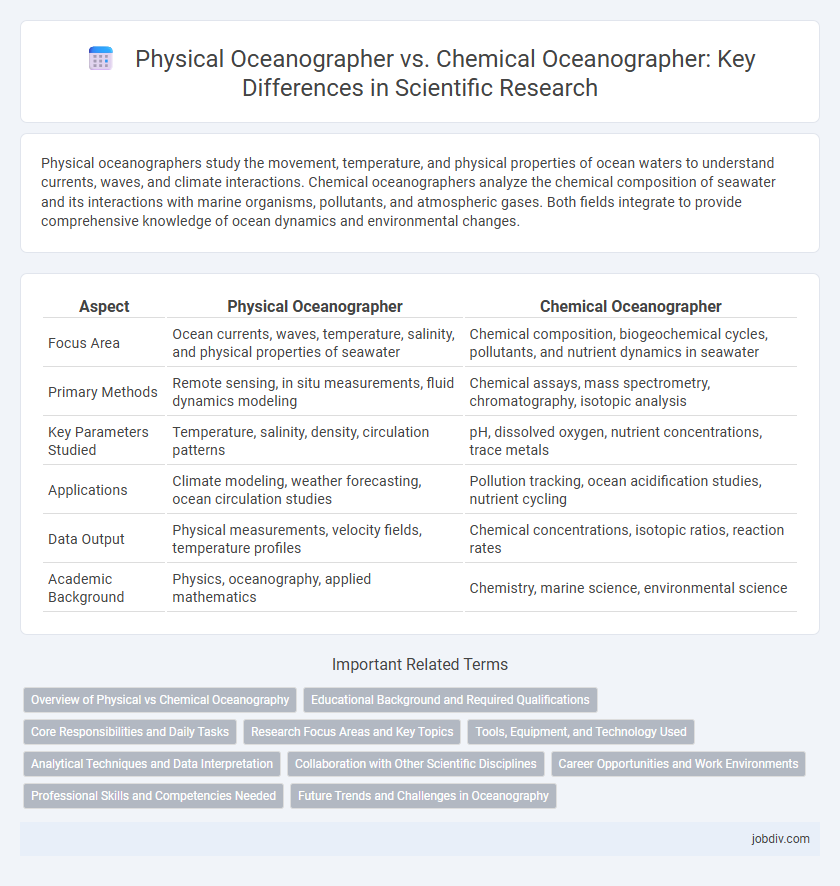Physical oceanographers study the movement, temperature, and physical properties of ocean waters to understand currents, waves, and climate interactions. Chemical oceanographers analyze the chemical composition of seawater and its interactions with marine organisms, pollutants, and atmospheric gases. Both fields integrate to provide comprehensive knowledge of ocean dynamics and environmental changes.
Table of Comparison
| Aspect | Physical Oceanographer | Chemical Oceanographer |
|---|---|---|
| Focus Area | Ocean currents, waves, temperature, salinity, and physical properties of seawater | Chemical composition, biogeochemical cycles, pollutants, and nutrient dynamics in seawater |
| Primary Methods | Remote sensing, in situ measurements, fluid dynamics modeling | Chemical assays, mass spectrometry, chromatography, isotopic analysis |
| Key Parameters Studied | Temperature, salinity, density, circulation patterns | pH, dissolved oxygen, nutrient concentrations, trace metals |
| Applications | Climate modeling, weather forecasting, ocean circulation studies | Pollution tracking, ocean acidification studies, nutrient cycling |
| Data Output | Physical measurements, velocity fields, temperature profiles | Chemical concentrations, isotopic ratios, reaction rates |
| Academic Background | Physics, oceanography, applied mathematics | Chemistry, marine science, environmental science |
Overview of Physical vs Chemical Oceanography
Physical oceanography investigates the dynamics of ocean currents, waves, and temperature distributions, emphasizing fluid movement and energy transfer within marine environments. Chemical oceanography examines the chemical composition of seawater, nutrient cycles, and the interactions between chemical substances and marine organisms. Both disciplines integrate to enhance understanding of ocean systems, but physical oceanographers primarily focus on physical processes, while chemical oceanographers analyze chemical properties and biogeochemical cycles.
Educational Background and Required Qualifications
Physical oceanographers typically hold degrees in physics, oceanography, or Earth sciences, emphasizing fluid dynamics, meteorology, and marine systems in their studies. Chemical oceanographers pursue education in chemistry, environmental science, or marine chemistry, focusing on the chemical composition and processes of seawater and marine sediments. Both require advanced degrees such as a master's or Ph.D., with strong backgrounds in quantitative analysis, laboratory skills, and field research methodologies.
Core Responsibilities and Daily Tasks
Physical oceanographers analyze ocean currents, waves, and temperature distributions to understand ocean dynamics and climate interactions, often deploying instruments like moorings and satellites. Chemical oceanographers study the composition of seawater, including nutrient cycles, contaminants, and biogeochemical processes, utilizing water sampling and laboratory analysis techniques. Both specialties collaborate to elucidate the ocean's role in Earth systems but concentrate on different data sets and methodologies to address marine scientific challenges.
Research Focus Areas and Key Topics
Physical oceanographers primarily investigate oceanic processes such as currents, waves, and heat transfer, emphasizing climate dynamics, ocean circulation, and the interactions between the ocean and atmosphere. Chemical oceanographers focus on the chemical composition and properties of seawater, studying biogeochemical cycles, nutrient distribution, and the impact of pollutants on marine chemistry. Both disciplines overlap in areas like ocean acidification and carbon cycling, crucial for understanding climate change and marine ecosystem health.
Tools, Equipment, and Technology Used
Physical oceanographers primarily use CTD (Conductivity, Temperature, Depth) sensors, acoustic Doppler current profilers (ADCP), and satellite altimetry to study ocean currents, temperature, and physical properties. Chemical oceanographers rely heavily on mass spectrometers, spectrophotometers, and automated water samplers to analyze chemical composition, nutrient levels, and trace elements in marine environments. Both disciplines utilize remotely operated vehicles (ROVs) and autonomous underwater vehicles (AUVs) equipped with specialized sensors to collect precise, in situ data for oceanographic research.
Analytical Techniques and Data Interpretation
Physical oceanographers employ techniques such as satellite remote sensing, acoustic Doppler current profilers, and in situ temperature-salinity sensors to analyze ocean circulation, waves, and thermohaline structures. Chemical oceanographers utilize chromatographic methods, mass spectrometry, and spectrophotometry to quantify nutrient cycles, trace metals, and dissolved gases, interpreting chemical distributions and transformations in marine environments. Data interpretation for physical oceanographers emphasizes fluid dynamics and physical processes modeling, whereas chemical oceanographers focus on biogeochemical interactions and reaction kinetics within oceanic systems.
Collaboration with Other Scientific Disciplines
Physical oceanographers collaborate extensively with meteorologists and climate scientists to model ocean-atmosphere interactions impacting global weather patterns. Chemical oceanographers work closely with marine biologists and geochemists to analyze nutrient cycles and pollutant dispersal in marine ecosystems. Their interdisciplinary partnerships enhance comprehensive understanding of ocean dynamics and biogeochemical processes essential for climate change research.
Career Opportunities and Work Environments
Physical oceanographers primarily study ocean currents, waves, and climate interactions, often working for government agencies, research institutions, or environmental consulting firms focused on climate science and marine resource management. Chemical oceanographers analyze the chemical composition of seawater and its biogeochemical cycles, typically employed in environmental monitoring, pollutant tracking, and marine ecosystem research within academia, regulatory bodies, and oil or chemical industries. Both careers offer opportunities in interdisciplinary projects involving climate change, marine conservation, and technological innovation in remote sensing and data modeling.
Professional Skills and Competencies Needed
Physical oceanographers require strong expertise in fluid dynamics, mathematical modeling, and data analysis to study ocean currents, waves, and climate interactions. Chemical oceanographers must excel in analytical chemistry, biogeochemical cycling, and laboratory techniques to investigate ocean composition, chemical processes, and pollution impacts. Both disciplines demand proficiency in remote sensing technologies, programming skills for data interpretation, and critical thinking to address complex marine environmental challenges.
Future Trends and Challenges in Oceanography
Physical oceanographers will increasingly rely on advanced remote sensing technologies and machine learning algorithms to model ocean circulation and predict climate impacts, addressing challenges of data integration from diverse sources. Chemical oceanographers face the critical task of monitoring ocean acidification and contaminant dispersion using high-resolution sensors, essential for understanding biogeochemical cycles amid accelerating anthropogenic changes. Both fields must overcome the hurdles of interdisciplinary collaboration and real-time data assimilation to enhance predictive accuracy in shifting marine environments.
Physical Oceanographer vs Chemical Oceanographer Infographic

 jobdiv.com
jobdiv.com